Share: 


"The fairwater sail or bridge fin is a totally undesirable appendage when viewed from any hydrodynamic or hydrostatic aspect or, indeed, from any other aspect including stealth."
Javier Silvano Arzola, Naval Engineers Journal, July 1999


 China has launched an unnamed ‘sailless’ submarine in Shanghai. It does technically have a sail, but it is barely a bump in the casing, possibly only covering a crew access and some mast heads. It is probably the first full-sized sailless submarine, but it the Chinese naval architects behind it are not the first to seriously consider this layout. This article looks at a few ‘sailless’ submarine designs.
China has launched an unnamed ‘sailless’ submarine in Shanghai. It does technically have a sail, but it is barely a bump in the casing, possibly only covering a crew access and some mast heads. It is probably the first full-sized sailless submarine, but it the Chinese naval architects behind it are not the first to seriously consider this layout. This article looks at a few ‘sailless’ submarine designs.

Soviet Navy: Pr.673
 Compared to the US Navy’s small and agile Skipjack Class submarines, the Soviet’s first generation Project 627 NOVEMBER Class nuclear powered attack submarines were generally considered an inferior design. So in the early 1960s Russian engineers started to design the follow-on attack submarines which would close the gap or exceed the American boats. Rather than stealth, they focused their attention on speed.
Compared to the US Navy’s small and agile Skipjack Class submarines, the Soviet’s first generation Project 627 NOVEMBER Class nuclear powered attack submarines were generally considered an inferior design. So in the early 1960s Russian engineers started to design the follow-on attack submarines which would close the gap or exceed the American boats. Rather than stealth, they focused their attention on speed.
Several innovative solutions were designed into the Project 673 boat. It was to be built from titanium alloys which are both lighter and stronger than steel and do not corrode. The nuclear reactor was to be a high-power lead-bismuth liquid-metal-cooled nuclear plant which had the feature of solidifying in case of a leak. This was both an effective safety feature and an Achilles’ heal as the reactor could not be brought back into operation if this occurred.
Original artwork. CLICK for HIGH-RESOLUTION image.
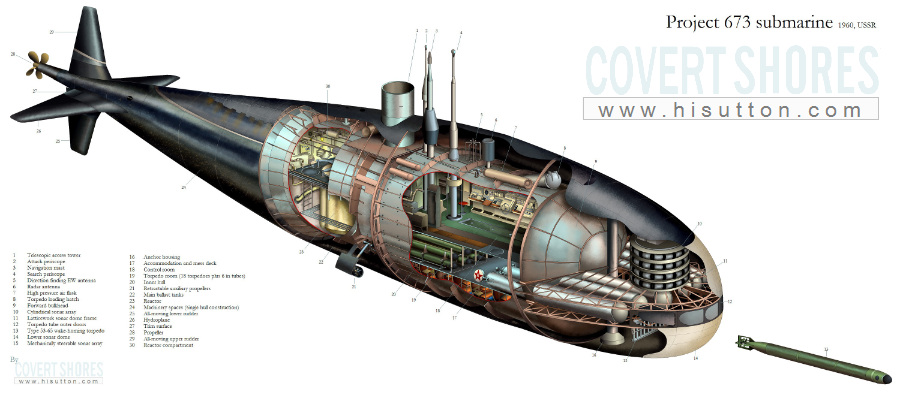
The most obvious external feature was that the design lacked a sail. Instead, a retractable tower acted as the bridge when the submarine was on the surface. This configuration reduced drag and made the boat more agile.
The Project 673 submarine was designed as an interceptor boat, to be kept in port and sent out in the event of an intruding NATO submarine. It was therefore designed for speed.
The project 673 design was too advanced for its time and the second generation of Soviet attack submarines were destined to be more modest, at least in design terms. The natural successor isseen as the Pr.705 ALFA Class which retained a sail, albeit a small streamlined one.
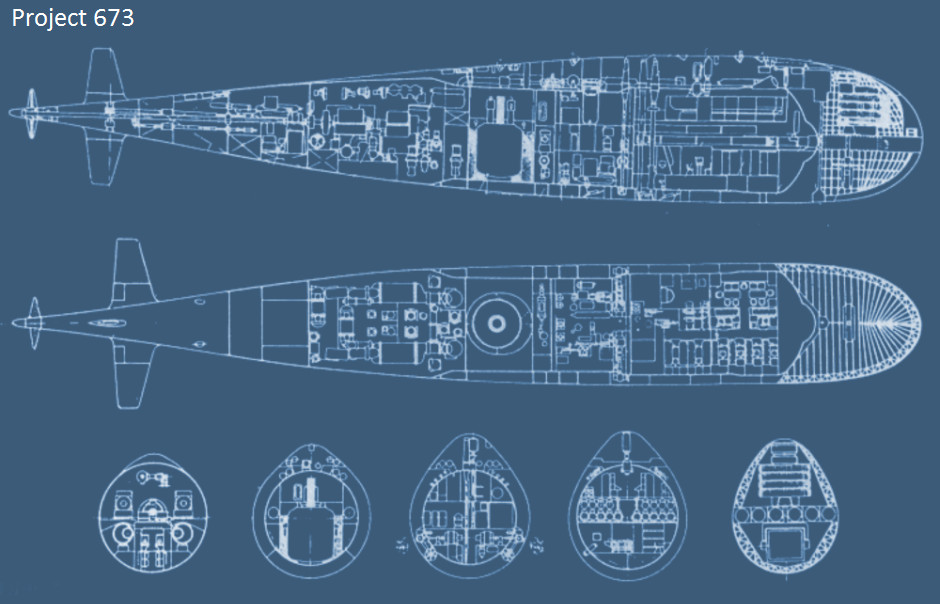
Get The essential guide to World Submarines
This Covert Shores Recognition Guide Covers over 80 classes of submarines including all types currently in service with World Navies.Check it out on Amazon
US Navy: CONFORM
 Facing off against the impressive high-speed Soviet ALFA Class attack submarine, the US Navy proposed the powerful 688 Class (later named Los Angeles Class) which promised speeds of 35 knots compared to ‘just’ 29 knots of the preceding 637 Sturgeon Class. The Los Angeles Class is now a well-known part of submarine history and is still in service today.
Facing off against the impressive high-speed Soviet ALFA Class attack submarine, the US Navy proposed the powerful 688 Class (later named Los Angeles Class) which promised speeds of 35 knots compared to ‘just’ 29 knots of the preceding 637 Sturgeon Class. The Los Angeles Class is now a well-known part of submarine history and is still in service today.
But it might never have been. Concerned that the 688 was going to be too large, too noisy and too expensive, a team of US Navy naval architects led by Capt. Donald H. Kern proposed the alterative CONFORM (Concept Formulation) design.
Although lower performing than the los Angeles class, the CONFORM design featured many innovations including a natural circulation reactor, twin contra-rotating screws and new stronger steel. But the most striking feature was (you’ve already guessed it…..), its lack of a conventional sail.
Instead there was a hump to cover a crew access and retractable folding masts.

Photos of a design model of CONFORM from Cold War Submarines by Norman Polmar and K. J. Moore. Highly recommended book! Amazon.
Although in some respects the home bet, the CONFORM design lost out to the Admiral Rickover (father of nuclear submarines) backed 688 Los Angeles design for primarily political reasons concerning the power plant. It is one of the wilder ‘what iff’s in naval history.
The ultimate book of Special Forces subs Covert Shores 2nd Edition is the ONLY world history of naval Special Forces, their missions and their specialist vehicles. SEALs, SBS, COMSUBIN, Sh-13, Spetsnaz, Kampfschwimmers, Commando Hubert, 4RR and many more.
Check it out on Amazon
Javier Silvano Arzola
Spanish naval architect Javier Silvano Arzola patented a concept submarine with broadside weapons tubes amidships, and minimal sail. See Espacenet.com His motivation for a sailless design was "To design an inherently faster, quieter, more stable and stealthier submarine by eliminating the fairwater sail or bridge fin." This is further explained in an article by Arzola in the Naval Engineers Journal, July 1999:
The fairwater sail or bridge fin is a totally undesirable appendage when viewed from any hydrodynamic or hydrostatic aspect or, indeed, from any other aspect including stealth. It causes considerable drag high above the centerline axis which causes a bow-up pitching moment which, in turn, ovemdes the other hydrodynamic effects on the hull and so determines the settings required on the forward and after hydroplanes to allow the submarine to maintain a straight and level path (Burcher and Rydill 1994).
When the submarine is heeled into a turn, the bridge fin causes lift which can result in a “snap-roll.” For this reason, some Navies have adopted separate two-man control for planes and helm thus increasing crew size (Friedman 1994).
At speed, this fin can generate vortices which produce noise. When surfaced, it is the single most visible and characteristic appendage of a submarine-typically offering over 350 square feet of visible area well above the waterline which announces “submarine” to any observer. It also adds considerable weight topside which is the worst possible place.
The hull of a 688 class submarine is about 33 feet in diameter but, because of the bridge fin, draws some 50 feet of water submerged. Furthermore thermore, at periscope depth, the top of the bridge fin is only a few feet under water where wave motion can affect the stability of the submarine and where there is a risk of collision-particularly in crowded coastal waters. The only reason ths appendage exists is because it is a convenient place to locate periscopes, antennas, snorkels, and a surface piloting or bridge position. In addition, the location of the control room underneath the bridge fin is dictated by the need to have the periscopes available there. The amount of space required by the periscopes also makes the control room much larger than would otherwise be necessary.
Naval Engineers Journal appears to have stopped publishing, but editions may be available from Wiley online library.
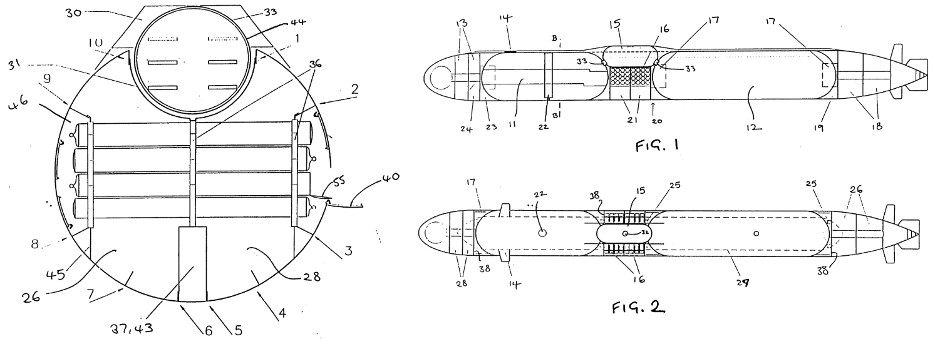
Patent illustrations, Arzola sailless design with broadside launch tubes amidships.
France; SMX-31
 The most obvious feature is this unbuilt concept submarine from Naval Group is the elimination of the sail (‘kiosk’ in French parlance), although there is a slight turtle-back covering the escape capsule. The pressure hull is buried within a lighter outer hull with the overall form influenced by the Sperm Whale:
The most obvious feature is this unbuilt concept submarine from Naval Group is the elimination of the sail (‘kiosk’ in French parlance), although there is a slight turtle-back covering the escape capsule. The pressure hull is buried within a lighter outer hull with the overall form influenced by the Sperm Whale:
Original Artwork, CLICK for HIGH RESOLUTION:
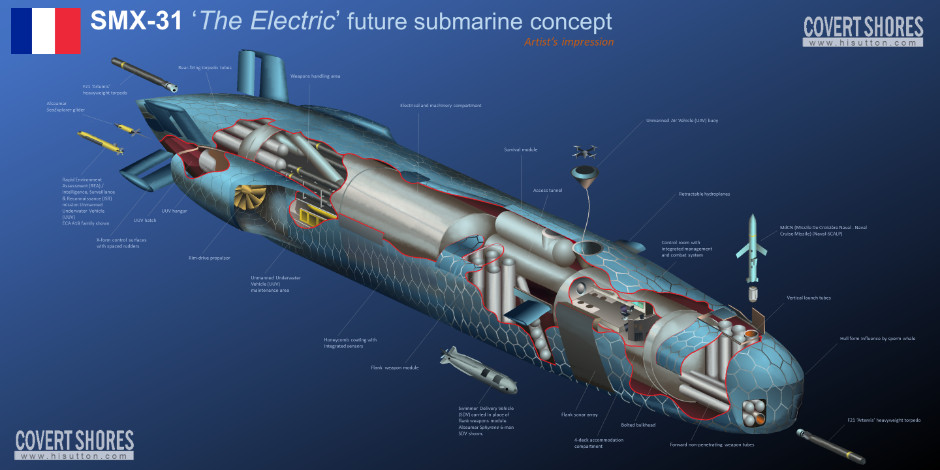
Although the boat retains mast-mounted sensors, it incorporates a number of less typical features to increase situational awareness and Intelligence, surveillance and reconnaissance features. An unmanned air vehicle (UAV) buoy can be deployed from up to 100 meters depth. The skin incorporates sensors and there is a large unmanned underwater vehicle (UUV) hangar at the stern with spacious UUV (/AUV) maintenance space inboard.
Related articles (Full index of popular Covert Shores articles)

 Chinese Sailless Submarine
Chinese Sailless Submarine

 Project 673 Advanced Submarine design. w/Cutaway
Project 673 Advanced Submarine design. w/Cutaway

 Swedish A21 Flundran AIP attack submarine
Swedish A21 Flundran AIP attack submarine

 British SSN(R) next generation Royal Navy SSN
British SSN(R) next generation Royal Navy SSN

 SMX-31 future submarine concept ('The Electric') w/Cutaway
SMX-31 future submarine concept ('The Electric') w/Cutaway

 Type-XXIXH stealth U-Boat. w/Cutaway
Type-XXIXH stealth U-Boat. w/Cutaway

 Project 685 MIKE Class deep-diving SSN
Project 685 MIKE Class deep-diving SSN

 Unbuilt US Navy spy submarine
Unbuilt US Navy spy submarine

 Project 705 'ALFA' class attack submarine. w/Cutaway
Project 705 'ALFA' class attack submarine. w/Cutaway

 USS Jimmy Carter (SSN-23) Special Mission submarine
USS Jimmy Carter (SSN-23) Special Mission submarine

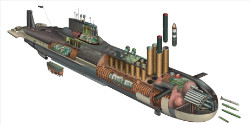 Russian Typhoon Class SSBN
Russian Typhoon Class SSBN

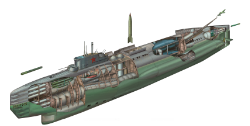 Stalin's Super Sub, Project P-2
Stalin's Super Sub, Project P-2



